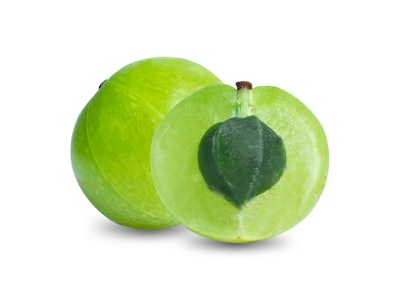
We have a few quiet assumptions we pick up from nature over the years. One is the relative importance of alternate members of many chemical sequences. delta-Decalactone and delta-dodecalactone are much more important than delta-nonalactone and delta-undecalactone in dairy flavors, for example. Within the category of aliphatic acids, we emphasize butyric, hexanoic and octanoic acids in dairy at the expense of the odd-numbered acids. This accords with nature but it may not always be the best practical choice. iso-Valeric acid (FEMA #: 3102, CAS #: 503-74-2) may be less abundant in nature, but it can sometimes outperform its even-numbered neighbors.
This Flavor Bites column can be found in the May 2024 issue.
The profile is very much stereotypical of the primary cheese odor, without any hint of the faint goaty character that starts to creep into the series of aliphatic acids from six carbon atoms upwards.
Note that the dose rates given throughout this article are the levels suggested for use in flavors intended to be dosed at 0.05% in ready-to-drink beverages or in a simple bouillon.
 iso-Valeric acid makes a subtle, but very useful, contribution to hazelnut flavors at 100 ppm.Adobe Stock
iso-Valeric acid makes a subtle, but very useful, contribution to hazelnut flavors at 100 ppm.Adobe Stock
Dairy Flavors
Butter, Fresh: iso-Valeric acid has a very similar profile to butyric acid but is much stronger. It has the added benefit of being more heat stable. One hundred ppm is a good level to start with.
Cheese, Blue: Levels in blue cheese flavors depend very much on the style of cheese, but 5,000 ppm is typical.
Cheese, Cheddar: The same 5,000 ppm level is effective in all cheddar cheese flavors.
Milk, Condensed: One hundred ppm of iso-valeric acid is ideal in condensed milk flavors.
Brown Flavors
Bread: iso-Valeric acid adds depth of taste to all types of bread flavors. Three hundred ppm is typical.
Chocolate: This ingredient works well in chocolate flavors at levels ranging from 100 ppm in very milky profiles up to around 1,000 ppm in very dark cocoa-dominated profiles.
Coffee: Six hundred ppm works well across most types of coffee flavors.
Honey: iso-Valeric acid works best in heavier, clover-style, honey flavors. Five hundred ppm is a good level.
Licorice: Fifty ppm of this ingredient adds depth of taste to authentic licorice flavors, but is not worth adding if the profile is overwhelmingly aniseed.
Malt: Malt and malted milk flavors both gain depth of taste from the inclusion of iso-valeric acid. Fifty ppm is an ideal level of addition.
Sugar, Brown: iso-Valeric acid provides a subtle depth of taste to brown sugar flavors. Levels vary but 50 ppm is, again, a reasonable indication.
Tea, Black: The heat stability of iso-valeric acid is very helpful in black tea flavors. Five hundred ppm is a typical level.
Vanilla, Bean: Authentic vanilla bean flavors seem to have a place in so very many of my articles. This is a reflection of genuine complexity. iso-Valeric acid may only play a very minor role, but 10 ppm does help to add realism.
Nut Flavors
Hazelnut: iso-Valeric acid makes a subtle, but very useful, contribution to hazelnut flavors at 100 ppm.
Peanut: The same level of 100 ppm is equally effective in peanut flavors as it is in hazelnut flavors.
Walnut: The 100 ppm level also applies to walnut flavors and other nut flavors, including almond and pistachio.
Savory Flavors
Bacon: This acid blends very harmoniously into all savory flavors, especially bacon flavors, at around 500 ppm.
Beef, Roast: The ideal level in roast beef flavors is lower, in the region of 80 ppm.
Bell Pepper: Roasted bell pepper and jalapeno flavors also benefit from a similar level of 80 ppm addition of iso-valeric acid.
Chicken: Three hundred ppm is a better level in most types of chicken flavors.
Fish Sauce: Levels in authentic fish sauce flavors can be very high, even up to 10,000 ppm.
Ham: Ham flavors vary considerably in respect of the level of smoked character, which is tied to the level of iso-valeric acid, ranging upwards from 100 ppm.
Smoke: Five hundred ppm is a reasonable level of iso-valeric acid in smoke flavors.
Soy Sauce: Soy sauce flavors cover a very wide range of profiles and the corresponding levels of iso-valeric acid also vary widely, from 100 ppm up to more than a 1,000 ppm.
Tomato, Processed: iso-Valeric acid has an interesting effect in all tomato flavors, but it is most useful in processed or dried profiles at 500 ppm.
Alcoholic Drink Flavors
Beer: iso-Valeric acid enhances the aroma and taste characteristics of all beer flavors. The ideal level depends on the type of beer. Light, lager-style beer flavors only need around 100 ppm. More robust styles can accommodate up to 800 ppm.
Brandy: The ideal levels in distilled spirit flavors are understandably much more modest, but the effect of 20 ppm in brandy flavors is still interesting.
Rum, Dark: A similar level can be useful in light rum flavors but up to 80 ppm works in dark rum flavors.
Whisky: Whisky flavors also benefit from around 20 ppm of iso-valeric acid, rounding out the profile and adding depth.
 Higher levels, up to several hundred ppm, add significantly to the aroma of gooseberry flavors.Adobe Stock
Higher levels, up to several hundred ppm, add significantly to the aroma of gooseberry flavors.Adobe Stock
Fruit Flavors
Apricot: Fifty ppm is a good starting point for this raw material in apricot flavors, obviously higher in dried apricot profiles, where it can enhance the effect of 2-methyl butyric acid.
Blackberry: Because iso-valeric acid is so powerful the levels of use in most fruit flavors are quite low. Twenty ppm works well in blackberry flavors.
Blackcurrant: Slightly higher levels, up to 40 ppm, are effective in blackcurrant flavors.
Blueberry: Authentic blueberry flavors also need around 40 ppm, but higher levels can work in some more abstract profiles.
Gooseberry: Higher levels, up to several hundred ppm, add significantly to the aroma of gooseberry flavors.
Lychee: Similar additions of iso-valeric acid can help to add depth and complexity to rose-tinted lychee flavors.
Peach: Butyric acid and hexanoic acid are often used in peach flavors. iso-Valeric acid works well at 100 ppm.
Pear: Fifty ppm is a good starting point for iso-valeric acid in pear flavors, providing an interesting alternative to hexanoic acid.
Raspberry: Raspberry flavors are quite similar to blackberry flavors but only need around 10 ppm of iso-valeric acid as a background note.
Strawberry: Levels vary in strawberry flavors but trend a little higher, from 40 ppm up.
Watermelon: iso-Valeric acid is effective in both realistic and fantasy watermelon flavors. Fifty ppm is a good place to start.










